Race Is on for Bots in Workers' Comp
Administrative costs in workers' comp can be enormous, but bots can shorten many procedures to mere minutes or even seconds.

Administrative costs in workers' comp can be enormous, but bots can shorten many procedures to mere minutes or even seconds.

Get Involved
Our authors are what set Insurance Thought Leadership apart.
|
Partner with us
We’d love to talk to you about how we can improve your marketing ROI.
|

John Bobik has actively participated in establishing disability insurance operations during an insurance career spanning 35 years, with emphasis on workers' compensation in the U.S., Argentina, Hong Kong, Australia and New Zealand.

Last week's news that the U.S. military was retiring a 50-year-old system of 8-inch floppy disks that helped control the nuclear arsenal reminded me of my own brush with outdated technology that could have led to Armageddon.
I was waiting to be interviewed by the History Channel for a special on the early days of the personal computer and was sitting on a couch at the front of a warehouse at Moffett Field that was the temporary home for items that now populate the Computer History Museum down the road in Mountain View, CA. In front of me was a coffee table that consisted of a round piece of clear plexiglass on top of a large, hollow cylinder full of wiring.
Was there a story behind that cylinder? I asked the museum curator.
Oh, he said, that's the guidance system from the nosecone of a Minuteman missile from the 1960s.
Yikes. That thing was supposed to accurately drop a nuclear warhead on a specific spot in the Soviet Union? It looked like one good kick or bit of turbulence would have dislodged enough wiring that the warhead would have landed on Tokyo, or Topeka, or would have just blown up in the missile silo.
But that nosecone turns out to be a good metaphor for how to handle information systems that simply can't lead to an error—including many in insurance.
Now, I'm not conflating any insurance error with Armageddon—no matter how much General Electric's miscalculations on long-term care might feel like doomsday for a company that long was one of the world's most-admired. But the long tail of many insurance contracts creates unusual pressure to avoid mistakes, as do regulatory watchdogs and the desire to treat customers as well as possible in their moment of need, when they have a loss and file a claim.
So, let's look at that nosecone.
The wiring was an aging technology even when implemented in the nosecone I saw and became positively antiquated as the years went along, given that guidance systems, driven by computer technology, have doubled in capability roughly ever year and a half since the '50s. But the wiring had been thoroughly tested, and it worked, once it was "ruggedized" enough to withstand the rigors of traveling through space. Sure, new guidance systems were demonstrably better, but would you bet the defense of the U.S. on their reliability? The fate of the world?
The same concern drove the technology decisions behind the moon landing in 1969. My microwave oven has far more computing power than Apollo 11, but the mostly hard-wired technology for the lunar mission had been tested in space, so advances in technology could wait for later programs.
Silicon Valley, despite its ethos about being on the cutting edge, sometimes takes the same, conservative approach. When I covered Intel for the Wall Street Journal, an executive described for me a process the company calls Copy Exactly. The idea made no sense at first blush: The company would build a chip-manufacturing facility by exactly copying an existing fab, even though Intel had learned in that existing fab how to correct all sorts of inefficiencies by improving a myriad of processes. Why not build all those updates into the new fab from the get-go? Because all the processes interact, and making a bunch of changes at once led to new sorts of problems popping up. Better to copy exactly and introduce the improvements one at a time, in a controlled way.
How do the military, NASA and Intel approaches apply to insurance?
At a high level, they suggest leaving legacy systems alone as much as possible. Yes, better technology is out there, and I'm sure that the many companies selling new software can make a compelling case for updating, but legacy systems are always a mess.
In the biggest technology transition that I've covered—the move from the mainframe era to "client-server" in the 1980s and 1990s—the quick, big wins went to those that focused less on the server piece and more on the client piece, the front end. Technology advances, driven by all those hungry insurtechs out there, allow for all kinds of ways to make improvements, especially in any process that touches a customer, without having to wade through all the back-end complexity.
Focusing on front-end technologies won't let you save humanity, but you could avoid some thorny issues and produce better results faster.
Cheers,
Paul Carroll
Editor-in-Chief
Get Involved
Our authors are what set Insurance Thought Leadership apart.
|
Partner with us
We’d love to talk to you about how we can improve your marketing ROI.
|

Paul Carroll is the editor-in-chief of Insurance Thought Leadership.
He is also co-author of A Brief History of a Perfect Future: Inventing the Future We Can Proudly Leave Our Kids by 2050 and Billion Dollar Lessons: What You Can Learn From the Most Inexcusable Business Failures of the Last 25 Years and the author of a best-seller on IBM, published in 1993.
Carroll spent 17 years at the Wall Street Journal as an editor and reporter; he was nominated twice for the Pulitzer Prize. He later was a finalist for a National Magazine Award.
Building an environment that offers low-cost, no-code functionality via API integration gives insurers real opportunity.

Get Involved
Our authors are what set Insurance Thought Leadership apart.
|
Partner with us
We’d love to talk to you about how we can improve your marketing ROI.
|
To drive innovation, Aegon says to leverage the blurring boundaries -- and pack your bags and move to Asia.

 So, you see that the need for these services is bigger than ever. But we also notice that, in certain markets, sometimes even the same markets where the latent need is getting bigger, actual demand is declining. How do you get to the customer in the right way?
Marco: “It’s about digital and data. This for us is the future, the Digital Insurance Agenda. With all due respect, if you're not digital in these days.… It’s as basic as plumbing. And data is where we can add much more value. To use our data, which we already have as an industry, and combine it with external data, we can be much more relevant for customers -- at the right moment with the right information, that is the nut that needs to be cracked. And a growing number of initiatives, like PSD2 in the banking area, enable us to have more access to data.”
In Asia, you already see digital platforms joining with insurers to share data for better underwriting and better targeting.
Marco: “Next to data and digital, you need an insurance product, but you need more than just that. Recently, I did a presentation for the insurance practice leaders of a global consulting firm. I told them that, if they would stick to insurance, they probably would face problems going forward. Because I believe you should not look at the opportunities strictly from an insurance point of view. Boundaries are blurring. Our business is much more than insurance. We are in financial services, but a customer doesn't mind whether the solution comes from an asset manager, a bank or an insurer. We need to broaden insurance to financial services.”
Could you give an example?
Marco: “Well, if you take our company in the Netherlands, our new business hardly comes from insurance. It is mortgages; we are a third-party administrator for pension providers. So, what formerly was an insurer now is a completely different company. That’s also reflected in our balance sheet: €316 billion assets under management. You may think we are more of an asset manager than an insurer.”
See also: A Game Changer for Digital Innovation
So, a key takeaway is that the future is about blurring boundaries. Then the obvious question would be, how do you manage this change?
Marco: “At Aegon, we use what we’ve coined the ‘core - satellite - universe’ approach. About 10 years ago, when I started with innovation, we first started in-house. We had some ideas, we wanted to create a new digital in-house bank, but it didn’t work out as we hoped for. Because in-house innovation is very difficult, almost impossible."
So, you see that the need for these services is bigger than ever. But we also notice that, in certain markets, sometimes even the same markets where the latent need is getting bigger, actual demand is declining. How do you get to the customer in the right way?
Marco: “It’s about digital and data. This for us is the future, the Digital Insurance Agenda. With all due respect, if you're not digital in these days.… It’s as basic as plumbing. And data is where we can add much more value. To use our data, which we already have as an industry, and combine it with external data, we can be much more relevant for customers -- at the right moment with the right information, that is the nut that needs to be cracked. And a growing number of initiatives, like PSD2 in the banking area, enable us to have more access to data.”
In Asia, you already see digital platforms joining with insurers to share data for better underwriting and better targeting.
Marco: “Next to data and digital, you need an insurance product, but you need more than just that. Recently, I did a presentation for the insurance practice leaders of a global consulting firm. I told them that, if they would stick to insurance, they probably would face problems going forward. Because I believe you should not look at the opportunities strictly from an insurance point of view. Boundaries are blurring. Our business is much more than insurance. We are in financial services, but a customer doesn't mind whether the solution comes from an asset manager, a bank or an insurer. We need to broaden insurance to financial services.”
Could you give an example?
Marco: “Well, if you take our company in the Netherlands, our new business hardly comes from insurance. It is mortgages; we are a third-party administrator for pension providers. So, what formerly was an insurer now is a completely different company. That’s also reflected in our balance sheet: €316 billion assets under management. You may think we are more of an asset manager than an insurer.”
See also: A Game Changer for Digital Innovation
So, a key takeaway is that the future is about blurring boundaries. Then the obvious question would be, how do you manage this change?
Marco: “At Aegon, we use what we’ve coined the ‘core - satellite - universe’ approach. About 10 years ago, when I started with innovation, we first started in-house. We had some ideas, we wanted to create a new digital in-house bank, but it didn’t work out as we hoped for. Because in-house innovation is very difficult, almost impossible."
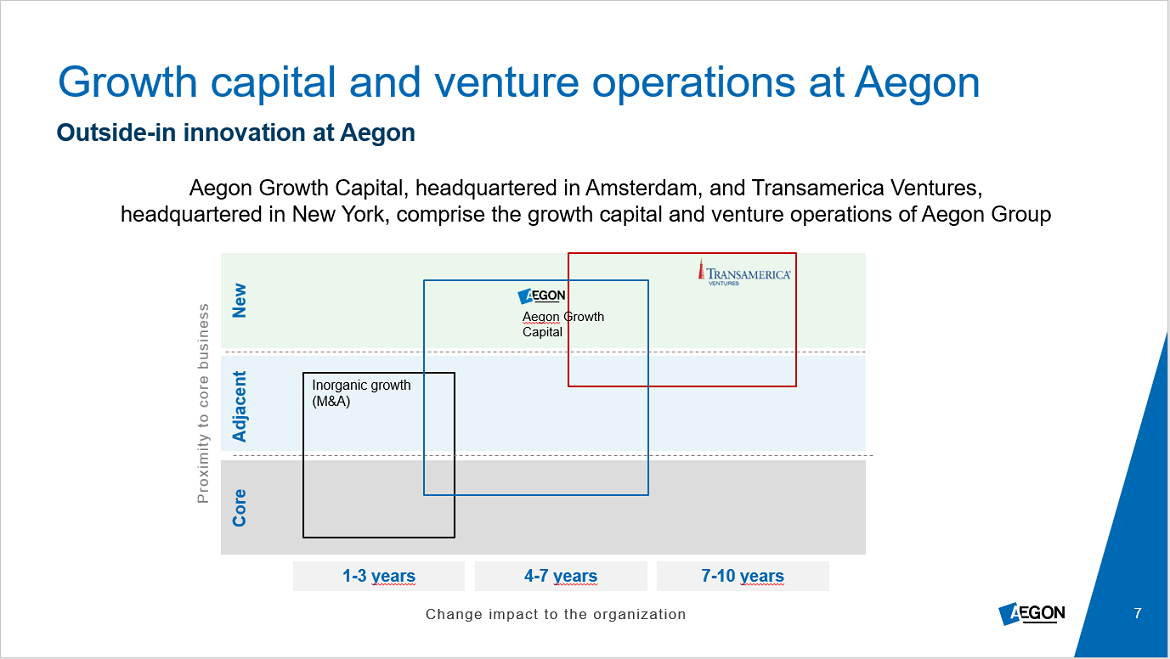 Most incumbents are not the best inventors in the world ...
Marco: “Indeed! So, we decided to do this differently. We realized that within our own environment the existing organisation is less open to everything that is new. That’s why we decided to create companies separate from the existing organisation that were still 100%-owned. One of these companies was Knab, a digital bank, which was set up at a different location and in a fully remote fashion with no interference from existing business. It focuses on individuals and the self-employed, and it is quite successful. It is the only profitable digital bank in Europe, and it has the highest NPS [Net Promoter Score]. But we actually made a very interesting mistake. We thought we wanted to disrupt the banks by offering more transparency, not hiding the hidden costs. So we decided to charge more than regular banks. Instead of €5 a month, we’d charge €15 a month but without hidden costs other banks charged, well in excess of the €15 a month. It turned out to be a disaster! The Dutch press opened with the line: 'Knab, the most expensive bank of the Netherlands.' We decided to pivot, go back to the €5, and now I dare to say it is quite a successful bank: Its rapidly growing customer base shows that it is a very attractive proposition for the self-employed, which is a growing market segment across the world.”
Most incumbents are not the best inventors in the world ...
Marco: “Indeed! So, we decided to do this differently. We realized that within our own environment the existing organisation is less open to everything that is new. That’s why we decided to create companies separate from the existing organisation that were still 100%-owned. One of these companies was Knab, a digital bank, which was set up at a different location and in a fully remote fashion with no interference from existing business. It focuses on individuals and the self-employed, and it is quite successful. It is the only profitable digital bank in Europe, and it has the highest NPS [Net Promoter Score]. But we actually made a very interesting mistake. We thought we wanted to disrupt the banks by offering more transparency, not hiding the hidden costs. So we decided to charge more than regular banks. Instead of €5 a month, we’d charge €15 a month but without hidden costs other banks charged, well in excess of the €15 a month. It turned out to be a disaster! The Dutch press opened with the line: 'Knab, the most expensive bank of the Netherlands.' We decided to pivot, go back to the €5, and now I dare to say it is quite a successful bank: Its rapidly growing customer base shows that it is a very attractive proposition for the self-employed, which is a growing market segment across the world.”
 Speaking of blurring boundaries, you have an interesting partnership with BCD Travel, with whom you launched GoBear in Asia. Can you tell a bit more about that?
Marco: “A lot of corporates invite us to do something together. That’s what happened with BCD, which is a worldwide travel agency with a lot of experience in Asia. Initially, we discussed selling travel insurance. Long story short, that’s how GoBear got started. Conceptually, it was more or less a copy of Skyscanner, but it is pivoting more to a financial supermarket than to an aggregator. It is now operating in seven Asian countries. Data is the key here. We own 50%.”
Based on your experience, should you always own 100% of a startup when you have the opportunity?
Marco: “My answer is clearly no. Having a 50% private equity partner disciplined us.”
At DIA, we see insurtechs operating in different business lines using the latest technologies. How do you, as an incumbent, make sure to have access to this cutting-edge knowledge?
Marco: “We realized we could never have access to that ourselves. That’s why we started Transamerica Ventures as one of the first corporate insurtech VCs in the industry. Here, we are looking for these cutting-edge companies, series A startups, that have certain very specific, extraordinary and technology-driven knowledge. We always look for a link with an Aegon entity so that we combine knowledge from outside with that of our existing businesses. We want to learn and make use of what is happening outside in the world, because we don't have the skills to develop it ourselves.”
Speaking of blurring boundaries, you have an interesting partnership with BCD Travel, with whom you launched GoBear in Asia. Can you tell a bit more about that?
Marco: “A lot of corporates invite us to do something together. That’s what happened with BCD, which is a worldwide travel agency with a lot of experience in Asia. Initially, we discussed selling travel insurance. Long story short, that’s how GoBear got started. Conceptually, it was more or less a copy of Skyscanner, but it is pivoting more to a financial supermarket than to an aggregator. It is now operating in seven Asian countries. Data is the key here. We own 50%.”
Based on your experience, should you always own 100% of a startup when you have the opportunity?
Marco: “My answer is clearly no. Having a 50% private equity partner disciplined us.”
At DIA, we see insurtechs operating in different business lines using the latest technologies. How do you, as an incumbent, make sure to have access to this cutting-edge knowledge?
Marco: “We realized we could never have access to that ourselves. That’s why we started Transamerica Ventures as one of the first corporate insurtech VCs in the industry. Here, we are looking for these cutting-edge companies, series A startups, that have certain very specific, extraordinary and technology-driven knowledge. We always look for a link with an Aegon entity so that we combine knowledge from outside with that of our existing businesses. We want to learn and make use of what is happening outside in the world, because we don't have the skills to develop it ourselves.”
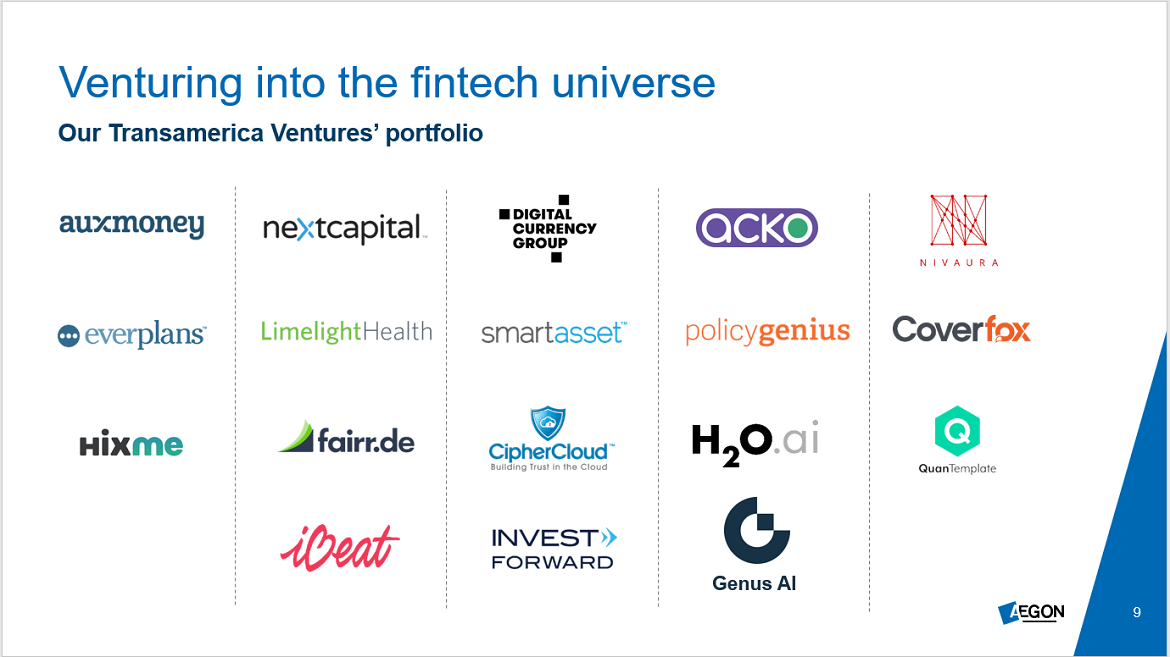 What about the companies selected, are you looking for specific solutions? Can you share a few names of the companies in the portfolio of Transamerica Ventures?
Marco: “Transamerica Ventures itself wants to have a return on the investments, of course. So, our criteria are that, as Aegon, we should be able to make use of their solutions. Let me share some examples:
Everplans developed a digital solution for estate planning. Our agents use this to increase interaction with customers and improve cross-sell and deep sell. By the way, here we own less than 5%, as we don’t strive for major influence or to have board seats.
Nextcapital is a robo adviser that we use for expiring pension policies. In case you have a defined contribution scheme, it supports in where to invest the money. A very innovative solution that we integrated in our core systems.
H2O.ai is an AI company. Almost seven units in Aegon are using their technology to advance AI.
In all three cases, we invested in the company but also helped them to get access to the corporate, to create use cases and to benefit from all the knowledge and experience we have. And in return we get access to their technology.”
More incumbents these days are setting up venture funds. What are your thoughts about that?
Marco: “There are a few challenges to deal with. Take the cultural challenge. It is still very difficult to get our own people excited about ideas they didn't invent themselves. But yes, it is true that more and more companies are creating such funds. So, if I would be a startup, I would really look at how sincere the fund is, what proof points they can show you, for instance on how to leverage their customer base. These days, startups have a choice. It is Aegon’s ambition to be the best partner and the best investor in series A for startups. We show the proof points. But we also show the cases where for whatever reason it didn't work out."
Recently, you set up the Aegon Growth Capital, a new fund investing in expansion and growth capital for fintech and insurtech companies. How did that come about?
Marco: “Apart from blurring boundaries, the unbundling of the value chain is also very important. Revenue pools are created outside our industry by companies now rapidly scaling up. For us, it’s very clear what our role is, what we do and what we shouldn’t do. That’s why we created a separate fund. This fund is run by professionals, and they manage it like a fund, and we, as a shareholder, are at a distance. So, if companies are doing business commercially with Aegon, the people they deal with are different from those who invest in their expansion and own the shares. Also, by using the fund, we don’t finance these investments from a budget. This avoids short-term discussions because at some point the investment could be perceived as an expense. We separate the shareholders’ discussions from the incumbent businesses to avoid interference. Gijs Jeuken, CEO of Aegon Growth, headed a company financed by a private equity firm himself, which after a steep growth path was acquired by Aegon. He knows first-hand the benefits of having access to growth equity, and the other side of the story.”
That’s an interesting lesson; if the incumbents start to interfere, in essence the whole system dies …
Marco: “We asked ourselves: ‘What is the future'? Our strong belief is that our type of companies are not able to reinvent themselves. You can put a lot of money in innovation labs and hiring people, but innovation is already happening outside. So why not look and invest in those companies that potentially, not per se, might be the future of our company. We learned a lot in the process. For instance - and this may sound a bit cynical, but it is the truth - if we own 50% or more we run the risk to kill the company. We learned this the hard way. So, our Growth Fund rather has a stake of, let's say 20-40%, and has private equity in it as well for financial discipline. Then, hopefully, we reach a point in time to get a bigger stake if the company is already sufficiently strong, and at least have made a good investment decision by backing the right entrepreneurs.”
See also: Focusing Innovation on Real Impact
So, you invest into companies you really believe in, and that will potentially be the future of Aegon. How does this work in practice?
Marco: “We focus on four segments. We strongly believe that the value chain in the financial industry will be completely disrupted. Only if you're extremely strong in every part of the value chain will you survive. Most of us are not strong in every part of the value chain, so we have to outsource it. Don’t try to own everything. Then the question is: 'Which part of the value chain is the most interesting part?' We believe those that are closest to the customer potentially create the biggest value. That's why two of the focus areas of the Growth Fund are digital/omni-channel distribution and customer engagement, content marketing and platforms. Furthermore, we focus on business process optimization and automation to decide on the new way of getting to customers in an efficient way, making use of digital and data, and still have the right products for the customer. Then we have asset and wealth management because, in a world where governments are retreating, it's very clear that customers have to do more themselves.”
What about the companies selected, are you looking for specific solutions? Can you share a few names of the companies in the portfolio of Transamerica Ventures?
Marco: “Transamerica Ventures itself wants to have a return on the investments, of course. So, our criteria are that, as Aegon, we should be able to make use of their solutions. Let me share some examples:
Everplans developed a digital solution for estate planning. Our agents use this to increase interaction with customers and improve cross-sell and deep sell. By the way, here we own less than 5%, as we don’t strive for major influence or to have board seats.
Nextcapital is a robo adviser that we use for expiring pension policies. In case you have a defined contribution scheme, it supports in where to invest the money. A very innovative solution that we integrated in our core systems.
H2O.ai is an AI company. Almost seven units in Aegon are using their technology to advance AI.
In all three cases, we invested in the company but also helped them to get access to the corporate, to create use cases and to benefit from all the knowledge and experience we have. And in return we get access to their technology.”
More incumbents these days are setting up venture funds. What are your thoughts about that?
Marco: “There are a few challenges to deal with. Take the cultural challenge. It is still very difficult to get our own people excited about ideas they didn't invent themselves. But yes, it is true that more and more companies are creating such funds. So, if I would be a startup, I would really look at how sincere the fund is, what proof points they can show you, for instance on how to leverage their customer base. These days, startups have a choice. It is Aegon’s ambition to be the best partner and the best investor in series A for startups. We show the proof points. But we also show the cases where for whatever reason it didn't work out."
Recently, you set up the Aegon Growth Capital, a new fund investing in expansion and growth capital for fintech and insurtech companies. How did that come about?
Marco: “Apart from blurring boundaries, the unbundling of the value chain is also very important. Revenue pools are created outside our industry by companies now rapidly scaling up. For us, it’s very clear what our role is, what we do and what we shouldn’t do. That’s why we created a separate fund. This fund is run by professionals, and they manage it like a fund, and we, as a shareholder, are at a distance. So, if companies are doing business commercially with Aegon, the people they deal with are different from those who invest in their expansion and own the shares. Also, by using the fund, we don’t finance these investments from a budget. This avoids short-term discussions because at some point the investment could be perceived as an expense. We separate the shareholders’ discussions from the incumbent businesses to avoid interference. Gijs Jeuken, CEO of Aegon Growth, headed a company financed by a private equity firm himself, which after a steep growth path was acquired by Aegon. He knows first-hand the benefits of having access to growth equity, and the other side of the story.”
That’s an interesting lesson; if the incumbents start to interfere, in essence the whole system dies …
Marco: “We asked ourselves: ‘What is the future'? Our strong belief is that our type of companies are not able to reinvent themselves. You can put a lot of money in innovation labs and hiring people, but innovation is already happening outside. So why not look and invest in those companies that potentially, not per se, might be the future of our company. We learned a lot in the process. For instance - and this may sound a bit cynical, but it is the truth - if we own 50% or more we run the risk to kill the company. We learned this the hard way. So, our Growth Fund rather has a stake of, let's say 20-40%, and has private equity in it as well for financial discipline. Then, hopefully, we reach a point in time to get a bigger stake if the company is already sufficiently strong, and at least have made a good investment decision by backing the right entrepreneurs.”
See also: Focusing Innovation on Real Impact
So, you invest into companies you really believe in, and that will potentially be the future of Aegon. How does this work in practice?
Marco: “We focus on four segments. We strongly believe that the value chain in the financial industry will be completely disrupted. Only if you're extremely strong in every part of the value chain will you survive. Most of us are not strong in every part of the value chain, so we have to outsource it. Don’t try to own everything. Then the question is: 'Which part of the value chain is the most interesting part?' We believe those that are closest to the customer potentially create the biggest value. That's why two of the focus areas of the Growth Fund are digital/omni-channel distribution and customer engagement, content marketing and platforms. Furthermore, we focus on business process optimization and automation to decide on the new way of getting to customers in an efficient way, making use of digital and data, and still have the right products for the customer. Then we have asset and wealth management because, in a world where governments are retreating, it's very clear that customers have to do more themselves.”
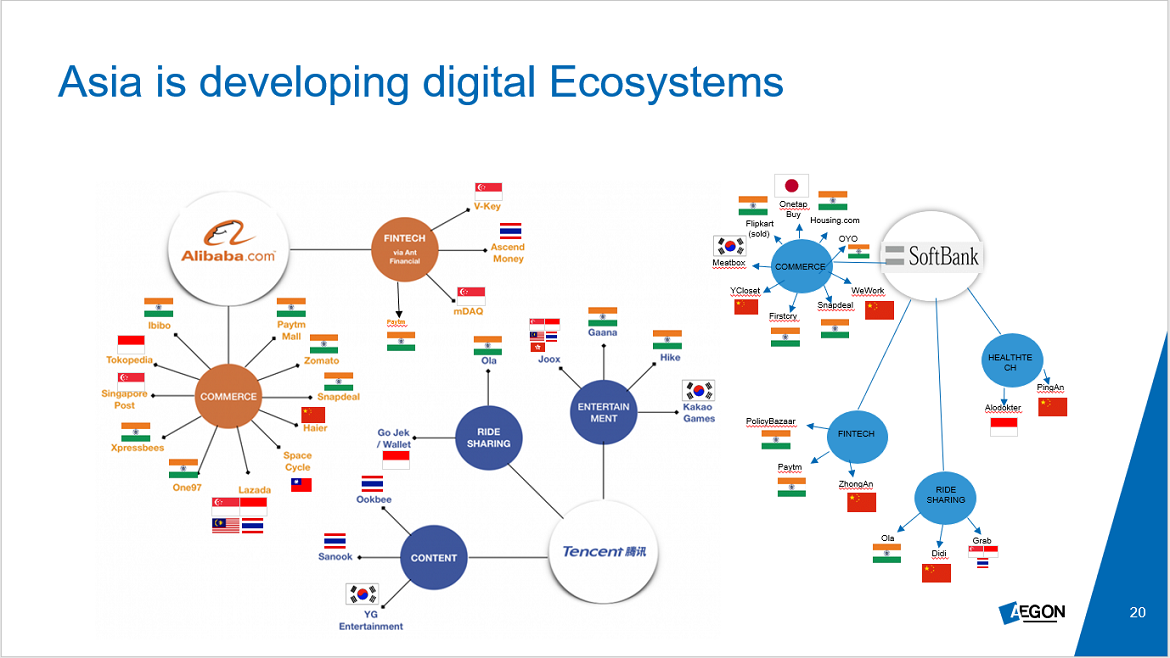 One of the main overarching themes of the 2019 DIA conferences is "East Meets West," because we believe there is so much we can learn from one another. What is your view on the developments happening in Asia?
Marco: “I have the privilege to travel to Asia about 10 times a year. Every time, it is a mind-boggling experience, and I’m flabbergasted when I come back. That’s where I get most of my energy from! The speed of change in Asia.... Here in Europe and America, we are somewhat behind the curve compared with what's happening over there! We must be careful not to become sitting ducks. Granted, Asian players can benefit from the big numbers, more (young) people, they don't have GDPR -- and I can find many more excuses. But the real differentiator is that they are much more entrepreneurial. They just try and do and act. They leapfrog, and that is what really resonated with me. Also when it comes to blurring boundaries, you see that all over the place in Asia. You see the big Asian tech firms expanding, really building huge ecosystems. A nice example is Go-Jek, the ‘motor Uber’ of Indonesia. But when you look at their offering ... they have everything, from insurance to banking, and you can even book a massage via their Go-Life app! We see more and more incumbents like ourselves teaming up with them. We are doing the same in India. Because this is the future. When you say that we learn a lot from Asia, I can only confirm.”
Any closing words for the DIA Community?
Marco: “Let me end with three takeaways: First, interact as much as possible with startups, and enjoy. The DIA conferences are the perfect place for this. Secondly, don't look at our challenges only from an insurance perspective, watch the blurring boundaries. We are in financial services. A customer doesn't know who has a license, they want a solution for their problem. Finally, pack your bags! Move to Asia and try to learn!”
One of the main overarching themes of the 2019 DIA conferences is "East Meets West," because we believe there is so much we can learn from one another. What is your view on the developments happening in Asia?
Marco: “I have the privilege to travel to Asia about 10 times a year. Every time, it is a mind-boggling experience, and I’m flabbergasted when I come back. That’s where I get most of my energy from! The speed of change in Asia.... Here in Europe and America, we are somewhat behind the curve compared with what's happening over there! We must be careful not to become sitting ducks. Granted, Asian players can benefit from the big numbers, more (young) people, they don't have GDPR -- and I can find many more excuses. But the real differentiator is that they are much more entrepreneurial. They just try and do and act. They leapfrog, and that is what really resonated with me. Also when it comes to blurring boundaries, you see that all over the place in Asia. You see the big Asian tech firms expanding, really building huge ecosystems. A nice example is Go-Jek, the ‘motor Uber’ of Indonesia. But when you look at their offering ... they have everything, from insurance to banking, and you can even book a massage via their Go-Life app! We see more and more incumbents like ourselves teaming up with them. We are doing the same in India. Because this is the future. When you say that we learn a lot from Asia, I can only confirm.”
Any closing words for the DIA Community?
Marco: “Let me end with three takeaways: First, interact as much as possible with startups, and enjoy. The DIA conferences are the perfect place for this. Secondly, don't look at our challenges only from an insurance perspective, watch the blurring boundaries. We are in financial services. A customer doesn't know who has a license, they want a solution for their problem. Finally, pack your bags! Move to Asia and try to learn!”
Get Involved
Our authors are what set Insurance Thought Leadership apart.
|
Partner with us
We’d love to talk to you about how we can improve your marketing ROI.
|
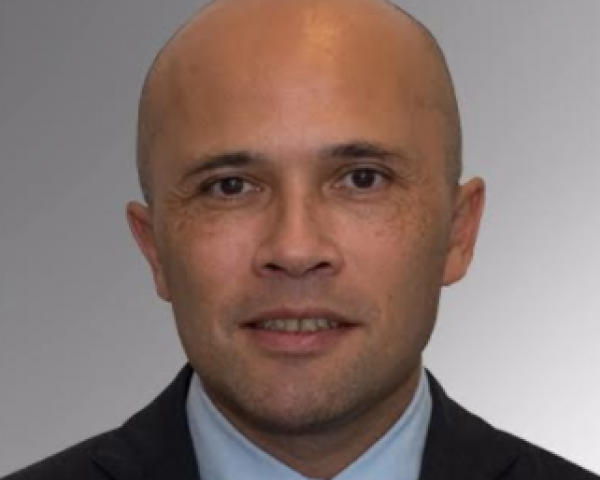
Roger Peverelli is an author, speaker and consultant in digital customer engagement strategies and innovation, and how to work with fintechs and insurtechs for that purpose. He is a partner at consultancy firm VODW.

Reggy de Feniks is an expert on digital customer engagement strategies and renowned consultant, speaker and author. Feniks co-wrote the worldwide bestseller “Reinventing Financial Services: What Consumers Expect From Future Banks and Insurers.”
Small businesses lose twice as much per scheme to white-collar crime as larger businesses, and detecting fraud typically took 16 months.

Get Involved
Our authors are what set Insurance Thought Leadership apart.
|
Partner with us
We’d love to talk to you about how we can improve your marketing ROI.
|
A Deloitte survey finds a recognition that there has been underinvestment in extended enterprise risk management.

Get Involved
Our authors are what set Insurance Thought Leadership apart.
|
Partner with us
We’d love to talk to you about how we can improve your marketing ROI.
|
After billions of dollars of underwriting losses in commercial auto, insurers can bend the curve toward profits.

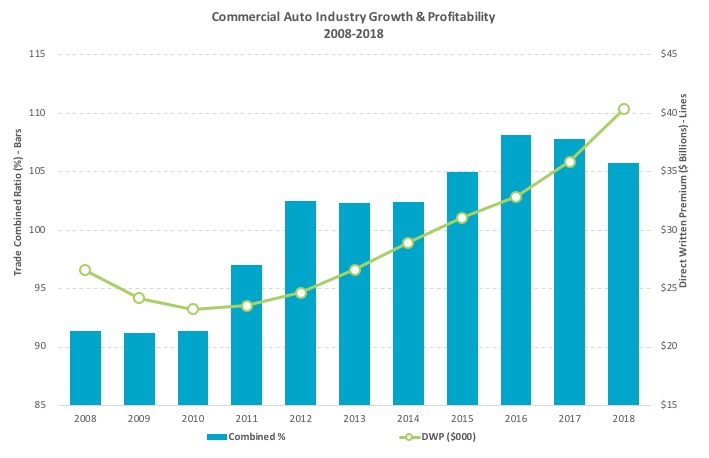 ©A.M. Best – used with permission[/caption]
Changes in risk exposure are pressuring insurers to improve pricing and underwriting effectiveness. As macroeconomic fundamentals remain strong, drivers are logging more miles and fleets are steadily growing, resulting in a shortage of experienced drivers, according to the Truck Driver Shortage Analysis conducted by ATA. With increases in exposure due to more miles driven, less-experienced drivers on the road and a rise in distracted driving incidents, it can be difficult to see how we can return to profitability anytime soon.
Choose a Smarter Path to Profitability
Despite these challenges, you can break the money-losing cycle of losses and create profit within your commercial auto book. A simple option is to increase base rates and risk alienating current and prospective clients. Alternatively, you can work more surgically, while improving your underwriting returns by using more data, information and technology.
See also: Cyber Insurance Needs Automated Security
There are a number of ways to improve your underwriting and pricing decision-making process and reclaim commercial auto profits:
©A.M. Best – used with permission[/caption]
Changes in risk exposure are pressuring insurers to improve pricing and underwriting effectiveness. As macroeconomic fundamentals remain strong, drivers are logging more miles and fleets are steadily growing, resulting in a shortage of experienced drivers, according to the Truck Driver Shortage Analysis conducted by ATA. With increases in exposure due to more miles driven, less-experienced drivers on the road and a rise in distracted driving incidents, it can be difficult to see how we can return to profitability anytime soon.
Choose a Smarter Path to Profitability
Despite these challenges, you can break the money-losing cycle of losses and create profit within your commercial auto book. A simple option is to increase base rates and risk alienating current and prospective clients. Alternatively, you can work more surgically, while improving your underwriting returns by using more data, information and technology.
See also: Cyber Insurance Needs Automated Security
There are a number of ways to improve your underwriting and pricing decision-making process and reclaim commercial auto profits:
Get Involved
Our authors are what set Insurance Thought Leadership apart.
|
Partner with us
We’d love to talk to you about how we can improve your marketing ROI.
|
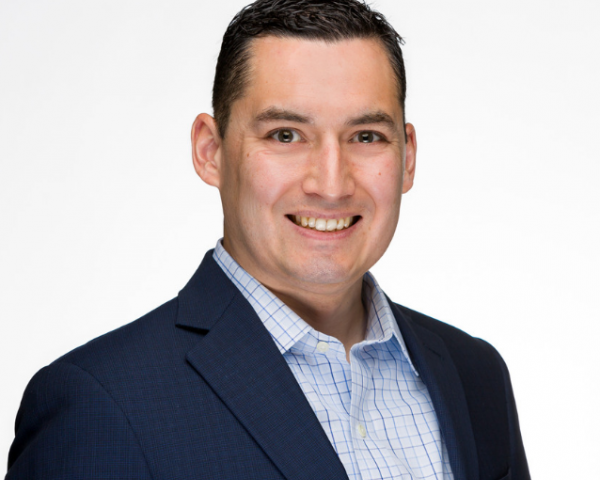
Patrick Foy is senior director of commercial insurance strategic planning at TransUnion.
How do you make sure customers are truly the focus of your business during every touchpoint with your brand?

Get Involved
Our authors are what set Insurance Thought Leadership apart.
|
Partner with us
We’d love to talk to you about how we can improve your marketing ROI.
|

Clarke's Third Law, posited by science fiction legend Arthur C. Clarke, says that "any sufficiently advanced technology is indistinguishable from magic." Well, we're going to see some magic, courtesy of the technology that led Google to claim "quantum supremacy" last week, and we should start adapting sooner rather than later.
The underlying technology, quantum computing, is as far from conventional computing as quantum physics is from the Newtonian view of the world and will have important implications for insurance.
Traditional computing is already pretty magical. Right, Siri? But traditional computing depends on a highly prescribed approach: Billions of transistors are in either an on or an off position, and problems are solved through an unbelievably fast manipulation of those 0 or 1 values, mostly in sequence. Quantum mechanics, meanwhile, operates in ways so mysterious that even Einstein was famously wary of the implications, and quantum computing is no different. Values don't have to be binary: they can be both 0 and 1 at the same time. (Told you this was weird stuff.) And all the values work together at the same time, not in sequence.
The Google claim of "quantum supremacy" means it believes it has solved a problem with a quantum computer that could not have been solved with a conventional computer. To be precise, Google says it solved a problem in three minutes and 20 seconds that would have taken the most powerful IBM supercomputer 10,000 years. IBM cried foul, saying its computer could have solved the problem in 2.5 days if the problem was set up right, but, even in the best-case scenario, IBM was 700 times slower.
Quantum computing will take an estimated 10 to 15 years to establish itself, which allows time for us to adapt—but not loads of time, in some areas. Quantum computing will render trivial today's approaches to encryption, which count on making problems (related to prime numbers) too hard to solve, and it takes about a decade to broadly replace one encryption scheme with a new one throughout industry. Quantum computing may require ending today's reliance on passwords and other computationally intensive schemes, in favor of sampling of DNA, fingerprints, retinal scans or other biometric evidence, and the switch can't start too early.
Richard Feynman famously said decades ago that chemistry isn't Newtonian, it's quantum, so any tool that's really going to help us understand chemistry needs to be based on quantum mechanics. Et voila. Such a tool is now in sight, and being able to simulate the quantum behaviors of atoms could lead to all sorts of new materials, new medicines and new understanding of the basic behaviors of our bodies—for instance, while we talk about DNA sequences and can define them, how the strands of protein fold up is also hugely important and has been hard for conventional computers to predict.
Quantum computing could also lead to much better models for the development of hurricanes and, more generally, for potential natural disasters. While such disasters occur at a massive scale, not at the subatomic, quantum level, the intricacies of the massive number of interactions lend themselves to a quantum computing approach.
Lots of deep analytics in insurance, such as looking for fraud or identifying patterns that can help mitigate risk, also lend themselves to a quantum approach.
And fundamentally new technologies like quantum computing often produce convergences with other technologies that can rewrite the business landscape. Think, for instance, about quantum computing powering the AI that goes into driverless cars. You don't think Google will hook up its "quantum supremacy" computer with the brain that powers all its autonomous vehicles?
Now, any technology that is expected to arrive some 10 years in the future can turn out to be mere science fiction—I'm still waiting for my flying car. And quantum computing has at least one clear drawback: It doesn't provide a definitely right answer like conventional computers do. The quantum world is probabilistic, so quantum computers just tell you an answer is probably right. If you test the problem enough times—Google tested 1 million times in those 200 seconds in its "quantum supremacy" experiment—you can be highly confident, but you still likely want to check your work with a conventional computer.
So, don't throw away your supercomputer just yet. But do start understanding quantum computing, and even experimenting. It's coming, and it will make today's AI seem like child's play. Quantum computing will pull new companies and even new industries out of the proverbial hat.
Paul Carroll
Editor-in-Chief
Get Involved
Our authors are what set Insurance Thought Leadership apart.
|
Partner with us
We’d love to talk to you about how we can improve your marketing ROI.
|

Paul Carroll is the editor-in-chief of Insurance Thought Leadership.
He is also co-author of A Brief History of a Perfect Future: Inventing the Future We Can Proudly Leave Our Kids by 2050 and Billion Dollar Lessons: What You Can Learn From the Most Inexcusable Business Failures of the Last 25 Years and the author of a best-seller on IBM, published in 1993.
Carroll spent 17 years at the Wall Street Journal as an editor and reporter; he was nominated twice for the Pulitzer Prize. He later was a finalist for a National Magazine Award.
Innovation comes from risk-taking, and learning and development (L&D) programs need to adapt to support those risks.

Get Involved
Our authors are what set Insurance Thought Leadership apart.
|
Partner with us
We’d love to talk to you about how we can improve your marketing ROI.
|